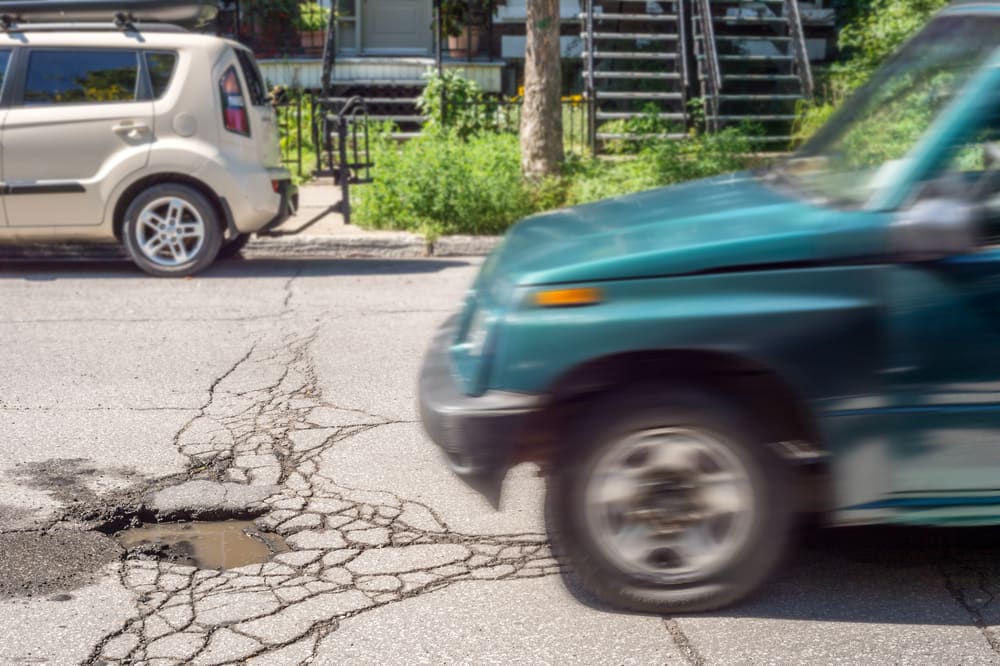Emmet Pierce
Few things are more unpleasant than the bone-rattling shock you feel when your car hits a pothole on the highway.
Rich White, executive director of the Car Care Council, says potholes normally occur during the winter and spring, when water penetrates cracks in the road and softens the underlying soil. Melted ice and snow can be the source of water that causes depressions in the asphalt.
The jarring impact you feel is followed by fear that the pothole you struck may have caused substantial damage to your vehicle. Poorly maintained roads often lead to auto insurance claims. And whenever you have a claim, there is a possibility that your premiums will increase, even if you aren’t at fault.
After you hit a pothole, it’s important to determine how badly your car was affected, says Dan Young, spokesman for the CARSTAR collision repair network.
“Don’t assume that nothing is wrong (just) because your car still is going down the road,” Young says.
The best thing to do is find a safe place to stop and give your car a visual inspection, he adds. Look for dents in the wheel rim or changes in the appearance of your tires. Determine if there are bulges in the tire sidewall or a reduction in air pressure.
If you discover any of these things, you’ll need to take your car to a repair technician for thorough inspection. In some cases, the damage may extend to the engine and exhaust system.

If your car pulls to one side when you steer, it could indicate an alignment problem, according to the nonprofit Car Care Council. Other abnormal movements, such as swaying when making turns or excessive bouncing may mean that the steering or the suspension has been damaged.
And damaged suspension can lead to more serious problems.
“The suspension issue might cause you to be unable to control the vehicle in difficult circumstances, like avoiding another car,” Young says. “A suspension problem can contribute to another accident.”
Using collision insurance
Any necessary repairs typically will be covered if you have a collision auto insurance policy, says Pete Moraga, spokesman for the Insurance Information Network of California.
Unlike liability insurance, which is mandatory in nearly every state, collision coverage is optional. It is used to repair your own vehicle in the event of an accident.
Keep in mind that if you have a deductible, it will apply to your collision claim, Moraga says. “If the damage is minor you might not meet the deductible threshold.”
For example, if you have a $500 deductible and the repair cost comes to $475, you’ll have to pay the entire bill. According to the nonprofit Insurance Information Institute, collision coverage typically has a deductible of between $250 and $1,000.
Some tires sustain greater damage
Kevin Connolly, a service advisor at Pacific Coast Tire and Service in Santa Monica, Calif., says not all tires hold up equally well when it comes to hitting potholes. Thin, low-profile tires are more susceptible to damage than standard tires. A low-profile tire has a very narrow sidewall. The sidewall is the side surface of the tire, between the edge of the tread and the rim of the wheel.
The American Automobile Association offers several tips for minimizing damage from potholes:
- Avoid driving over standing water that may be concealing potholes.
- Maintain the proper air pressure in your tires to provide an adequate cushion between the road and the tire rim.
- Leave plenty of space between your car and the car in front of you so you can spot potholes in the road ahead.
- If you can’t avoid hitting a pothole, slow down and keep a firm grip on the steering wheel to help you maintain control of the vehicle.
